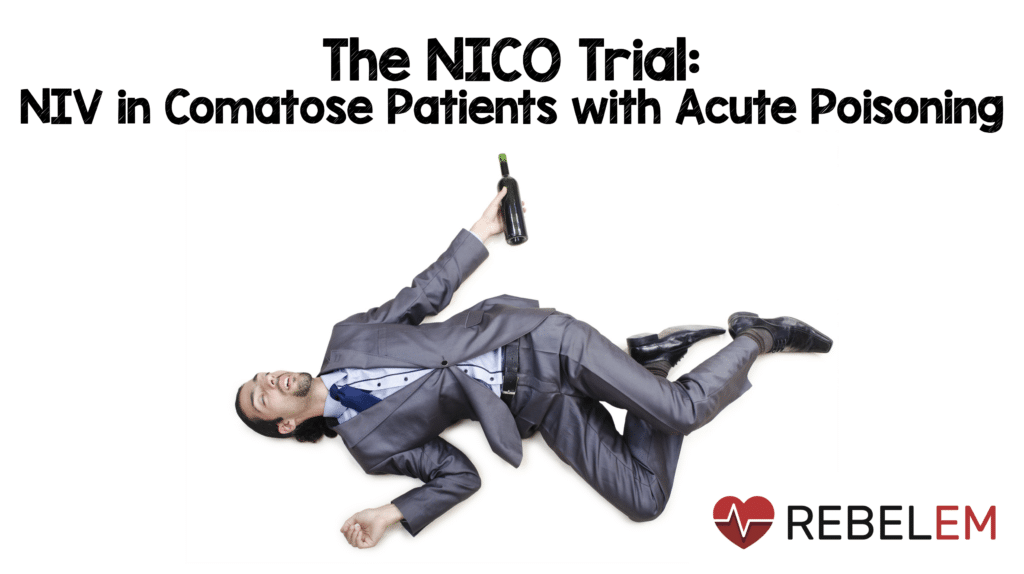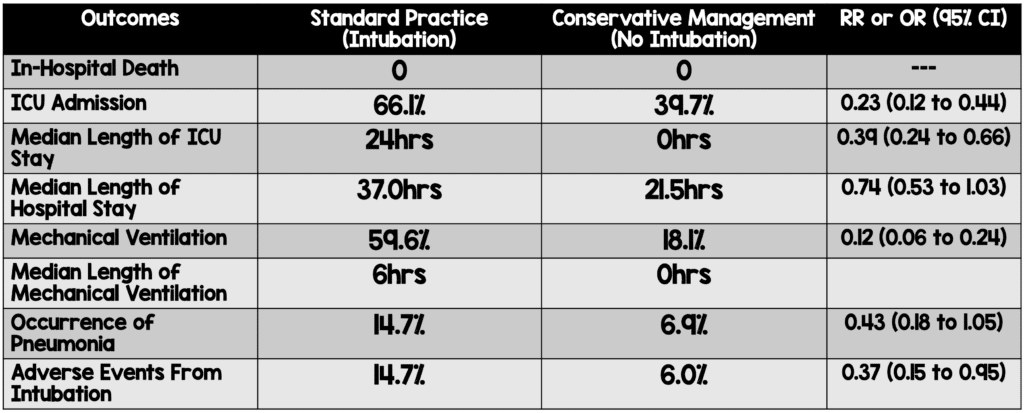
Paper: Freund Y et al. Effect of Noninvasive Airway management of Comatose Patients with Acute Poisoning: A Randomized Clinical Trial. JAMA 2023. PMID: 38019968
Clinical Question: In patients with suspected acute poisoning and GCS <9, is a conservative airway strategy of withholding intubation associated with a reduction in death, ICU LOS, and hospital LOS compared with routine practice of intubation?
What They Did:
- Multicenter, unblinded, randomized, parallel-group clinical trial
- 20 EDs and 1 ICU in France
- Comatose patients with suspected acute poisoning and GCS <9
- Randomized 1:1 to
- Standard Practice : Intubation Group
- Seizure
- Respiratory distress (SpO2 <90% persisted after nasal cannula)
- Vomiting
- Shock (SBP <90mmHg persisted after 1L crystalloid)
- Conservative Practice: No Intubation Group
- Intubation left to discretion of treating physician
- In patients where intubation required
- Induction drug: Either etomidate or ketamine
- Paralytic drug: Either succinylcholine or rocuronium
- Preoxygenation: Maintaining SpO2 100% for 2min; If patient remained hypoxemic, NIV was permitted
- Laryngoscopy: Use of DL or VL and use of bougie or stylet left to the discretion of the physician
- Waveform capnography was recommended to confirm ETT position
- Standard Practice : Intubation Group
Outcomes:
- Primary: Hierarchal composite endpoint of in-hospital death, length of ICU stay, and length of hospital stay
- Key Secondary:
- Adverse events resulting from intubation
- Pneumonia within 48 hours
Inclusion:
- Adult patients ≥18 years of age
- Clinical suspicion of acute poisoning
- Decreased level of consciousness (GCS <9)
Exclusion:
- Pregnant
- Incarcerated or Involuntarily detained
- Immediate need for tracheal intubation (Defined by signs of respiratory distress, clinical suspicion of any brain injury, seizure, or shock)
- Any suspicion of cardiotropic drug poisoning (Beta blockers, calcium channel inhibitors, or angiotensin-converting enzyme inhibitors)
- Intoxication with a single toxic substance that could be reversed (opioids and benzodiazepines)
Results:
- 225 patients
- Mean age: 33 years
- Median GCS: 6 (Range 3 to 7)
- Alcohol was the implicated toxin in 67% of cases
- 116 intervention group (16% intubation rate)
- 109 in the control group (58% intubation rate)
- Hierarchical Composite Primary End Point was improved in the avoid intubation group compared to the intubation group: Win ratio 1.85; 95% CI 1.33 to 2.58; p < 0.001

Strengths:
- Asks a clinically important question
- Groups well balanced at baseline
- Randomization appropriately performed to avoid bias
- Multicenter increasing external validity
- Only RCT to date comparing conservative to standard practice of intubation in patients with decreased GCS due to acute poisoning
Limitations:
- Unblinded study could lead to a Hawthorne effect that may have influenced physician behavior on the decision to intubate
- Primary outcome driven by reduction in ICU LOS (i.e. not a patient oriented outcome)
- Single country study which may limit generalizability
- Excluded pregnancy where risk of emesis is increased due to gravid uterus
- Alcohol was the implicated in the overwhelming majority of patients. This decreases generalizability to other substances.
- Unclear monitoring strategy for patients not intubated or in the conservative arm
Discussion:
- No patient was treated with gastric evacuation nor activated charcoal in this trial
- In this trial there was an absolute reduction of 7.8% of the risk of pneumonia by not intubating patients (NNT = 13)
- Additionally there was an absolute reduction of 12.2% of the risk of first pass failure by not intubating patients as well (NNT = 8)
Author Conclusion: “Among comatose patients with suspected acute poisoning, a conservative strategy of withholding intubation was associated with a greater clinical benefit for the composite end point of in-hospital death, length of ICU stay, and length of hospital stay.”
Clinical Take Home Point: In patients with decreased level of consciousness due to acute poisoning a conservative strategy of withholding intubation leads to less ICU admissions, median length of ICU/hospital stay, and a lower risk of adverse events.
References:
- Freund Y et al. Effect of Noninvasive Airway management of Comatose Patients with Acute Poisoning: A Randomized Clinical Trial. JAMA 2023. PMID: 38019968
Post Peer Reviewed By: Anand Swaminathan, MD (Twitter/X: @EMSwami)



